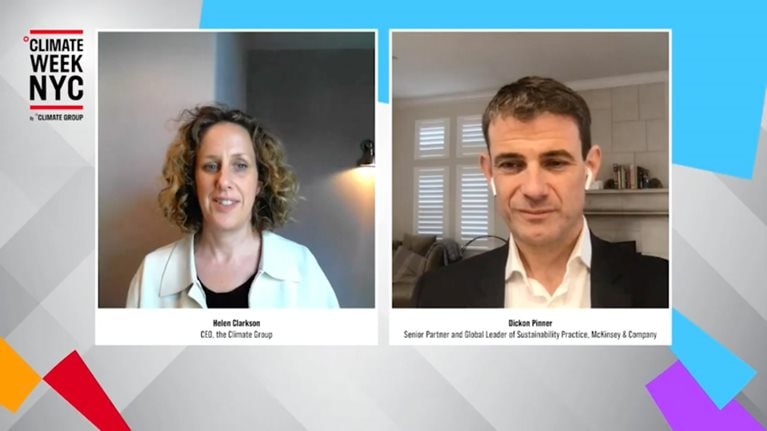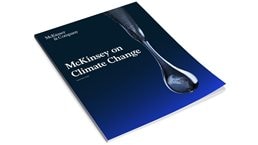This week, McKinsey joined other organizations at Climate Week NYC to discuss ways we can recover from COVID-19 while simultaneously addressing environmental challenges. Ahead of the event, we released a compendium on climate change. Here are six sustainability priorities from our research that can help us on the path to The Next Normal.
1. Prioritizing a green COVID-19 recovery
As our global managing partner Kevin Sneader recently told GZERO, “Coronavirus holds profound lessons that can help us address climate if we make greater economic and environmental resiliency core to the recovery.” The period after the pandemic will determine whether the world meets or misses the emissions goals of the 2015 Paris Agreement, which were set to limit global warming to 1.5°C to 2°C. An estimated $10 trillion will be spent globally in recovering from COVID-19. Our research shows that a low-carbon recovery could not only significantly reduce emissions, but also create more jobs and economic growth than a high-carbon recovery would. In fact, our analysis of stimulus options for a European country suggests that mobilizing €75 billion to €150 billion of capital could yield €180 billion to €350 billion of gross value added, create up to three million new jobs, and enable a carbon-emissions reduction of 15 to 30 percent by 2030.
2. Allocating and reallocating capital

Capital allocation and reallocation is the key to a green recovery. The good news is that global finance has already mobilized, and low interest rates mean that the cost of capital for sustainability investments has never been lower. Recently, the risk-reward equation for sustainability investments has flipped. Carbon intensive investments that used to be safe are now seen as risky, and the clean alternatives that were seen as risky are now seen as safe. For example mature energy technologies such as solar, wind, battery storage, and electric vehicles no longer need subsidies to be affordable and, for some, costs continue to decline.
In addition, well-functioning voluntary carbon markets—in which private investors, governments, non-governmental organizations, and businesses can voluntarily purchase carbon offsets for their emissions—will be critical to reaching net zero and net negative goals. In conversations and announcements during Climate Week NYC this week, we see that the demand for these markets is significant, which will require the buildup of supply for carbon offsets and robust mechanisms for their certification and verification.
3. Adapting to existing physical risk
The physical impact of rising global temperatures is already presenting challenges to communities around the world. As Earth’s climate gets warmer, acute hazards such as heat waves and floods grow in frequency and severity, while chronic dangers such as drought and rising sea levels intensify. Not only could climate change create inequality—simultaneously benefiting some regions while hurting others—within regions, the poorest communities and populations are typically the most vulnerable to climate events.
According to research from the McKinsey Global Institute, these physical risks from climate change will also translate into increased socioeconomic risk, raising new questions for business leaders and policymakers alike. For example, long-accepted engineering parameters for infrastructure design may need to be rethought; homeowners and banks may need to adjust assumptions about long-term mortgages.
4. Accelerating decarbonization
The power sector was undergoing a global transformation before the pandemic, as lower costs made renewables competitive with conventional fuels. As COVID-19 has created greater urgency to address climate change, accelerating decarbonization across sectors could reduce the level of greenhouse gas emissions required to meet the goals of the 2015 Paris Agreement. Our report shows the fashion industry, for example, was responsible for some 2.1 billion metric tons of greenhouse-gas (GHG) emissions in 2018, about 4 percent of the global total—and about the same quantity of GHGs per year as the entire economies of France, Germany, and the United Kingdom combined. Fashion manufacturers and fiber producers could significantly reduce their emissions by decarbonizing material production and processing, minimizing production and manufacturing waste, and increasing use of sustainable transport and packaging, among other efforts.

McKinsey on Climate Change
This collection brings together recent McKinsey research and perspectives on the climate risks the world must confront and actions to reduce emissions.
5. Protecting natural capital
Natural capital provides critical services and resilience, from supporting water cycles and soil formation to absorbing CO2 and protecting communities from storms, floods, fires, and desertification. But studies show human activity is eroding the value generated by natural capital: For example, deforestation is responsible for as much as 14 percent of global carbon emissions, accelerating climate change and increasing the frequency of extreme weather events. Our research suggests that doubling nature conservation by 2030 could have a significant impact for both the environment and economy, including reduced atmospheric CO2 by 0.9 gigatons to 2.6 gigatons annually, up to 650,000 new jobs in conservation-related fields, and lowered risks for new zoonotic diseases.
6. Transforming corporations at scale
This week our firm joined other organizations at Climate Week NYC to discuss how we can all work together to accelerate climate action. As McKinsey senior partner and global leader of our Sustainability practice Dickon Pinner says, responding to climate change—and meeting the 2015 Paris Agreement goals—will require global corporations to transform at scale. “The magnitude of our climate challenge will require rapid action across every part of the economy,” he says. “What countries, businesses, and individuals do in the next decade will decide what world future generations will live in. Tackling climate risk won’t be easy, but it will be worth it to build a more prosperous, equitable, resilient, and sustainable world.”
